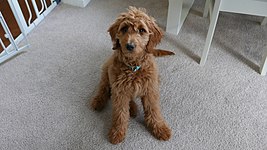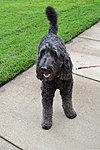Goldendoodle
| Goldendoodle | |||||||||||||||||||||||||||||||||||||
|---|---|---|---|---|---|---|---|---|---|---|---|---|---|---|---|---|---|---|---|---|---|---|---|---|---|---|---|---|---|---|---|---|---|---|---|---|---|
 | |||||||||||||||||||||||||||||||||||||
| Common nicknames | Doodle | ||||||||||||||||||||||||||||||||||||
| Origin | Australia & United States | ||||||||||||||||||||||||||||||||||||
| Foundation stock | Golden Retriever & Poodle | ||||||||||||||||||||||||||||||||||||
| Breed status | Not recognized as a breed by any major kennel club. | ||||||||||||||||||||||||||||||||||||
| |||||||||||||||||||||||||||||||||||||
| Dog (domestic dog) | |||||||||||||||||||||||||||||||||||||
The Goldendoodle is a designer dog created by crossbreeding a Golden Retriever and a Poodle. First widely bred in the 1990s, they are bred in three different sizes—each corresponding to the size of Poodle used as a parent.
Goldendoodles often demonstrate Golden Retrievers' intuitive and human-oriented nature in addition to the intelligent personality and "allergy-friendly" coat of a Poodle.[1]
History[edit]
In the 1990s, designer dog breeders in Australia and the United States (Ryan Harvey) started to widely cross Golden Retrievers and Poodles, adopting the term goldendoodle to describe the cross.[2] The name doodle is also used to describe this crossbreed. The name goldendoodle is derived from "golden" (from Golden Retriever) and "Labradoodle" (itself a portmanteau of Labrador Retriever and a Poodle).[3][4] Deliberately breeding Poodles with Golden Retrievers actually preceded the 1990s. An example of this was done by Monica Dickens, the great-granddaughter of Charles Dickens, who crossed the two breeds in 1969.[5] The cross can result in a healthier animal than both parent breeds.[6][1][7]
The original aim of the goldendoodle's breeders was to produce an alternative to the popular labradoodle.[3] Initially goldendoodles were only bred from standard-sized Poodles, but designer breeders also started using small varieties of Poodles to create a smaller crossbreed.[2] As they are a crossbreed, they are not recognized by the AKC, FCI or British Kennel Clubs. Goldendoodles have been developed beyond the F1 (Golden Retriever crossed with a Poodle) and are now available in deeper generations created by crossing two goldendoodles. These are called multigenerational or multigen goldendoodles.[citation needed]
Characteristics[edit]
Appearance[edit]
The appearance, size, and coat of goldendoodles can vary considerably according to their breeding generations and what type of Poodle parents they have.[1] While most goldendoodles share common traits, each goldendoodle might have its own unique appearance and temperament.[8]

In general, goldendoodles have round skulls, broad muzzles, heavily feathered tail, drop ears, and oval-shaped eyes.[2] Goldendoodles' retriever parentage makes their body long and muscular, and likely to have a deep chest and wide stance.[1]
The goldendoodle can be bred from any one of the Standard, Miniature or Toy-sized Poodles, the resultant offspring coming in several sizes: the standard, medium and miniature goldendoodles.[2] The standard goldendoodle typically stands 20 to 25 inches (51 to 64 cm) and weighs 51 to 80 pounds (23 to 36 kg), the medium goldendoodle typically stands 17 to 20 inches (43 to 51 cm) and weighs 36 to 50 pounds (16 to 23 kg), and the miniature goldendoodle typically stands up to 20 inches (51 cm) and weighs 15 to 35 pounds (6.8 to 15.9 kg)
The goldendoodle is a long-haired dog breed and their coat can vary considerably, there are three main coat types: straight, wavy and curly.[2] Wavy coated goldendoodles are a combination of the Poodle's curly coat and the Golden Retriever's straight coat. Their coat is wavy, with loose, shaggy curls. This type of coat is the most common amongst goldendoodles. Curly coated goldendoodles resemble the coat of a Poodle. Their coat is thick and curly.[2] Goldendoodle coats come in varying colors, with the most common colors being cream, red, black, gold, apricot, brown, or a combination (parti-colored).[1]
Goldendoodles are often claimed to be 'hypoallergenic' or 'non-shedding'.[2] However research has shown that hypoallergenicity can not be an official dog breed characteristic.[9] AKC also asserts that "there is no such thing as a completely hypoallergenic dog".[10]
It used to be thought that the higher the percentage of Poodle is in a goldendoodle's heritage, the less likely it is to shed.[1] It was also thought that curlier coated goldendoodles tend to shed lighter and produce less dander.[2]
-
Cream goldendoodle
-
Apricot goldendoodle
-
Red goldendoodle
-
Silver goldendoodle
Behavior[edit]
Similar to most crossbreed dogs, goldendoodles tend not to have the same predictable temperament or patterning aspects that the constituent breeds have.[8] Based on genetic theory, well-bred goldendoodle should express behaviours intermediate to their parent breeds.[11]
In general, goldendoodles tend to take on Golden Retrievers' friendly, affectionate, trustworthy and enthusiastic nature;[1] whilst also demonstrating Poodles' reputable intelligence, sociability and trainability.[1] Goldendoodles predominantly exhibit high energy level, loyalty and playfulness;[1] they are friendly with children and considered a good family pet. Because they are so friendly and loyal, however, they are prone to separation anxiety, especially as puppies.[1][12] The crossbreed often exhibits strong retriever instincts inherited from its gundog parent breeds,[12] which make them have an active mouth and high tendency to retrieve objects.[1]
A 2019 behavioural study compared goldendoodles to their parent breeds, on average Goldendoodles displayed greater dog-rivalry, dog-directed aggression, dog-directed fear, and stranger directed fear than purebred Golden Retrievers or Poodles.[6][contradictory]
Health[edit]
Goldendoodles may avoid inheriting disease or health issues from parents, but may alternatively be susceptible to more health issues if the parents are unhealthy to begin with.[7]
The goldendoodle has a predilection to megaesophagus.[13]
Popularity and uses[edit]

Primarily bred as companion dogs, goldendoodles have been successfully trained as therapy dogs, guide dogs,[3] nut-detection dogs detecting nuts in food for people with nut allergies,[14] and other forms of assistance dogs.[15]
In some regions of the United States it has become one of the most popular dog varieties.[16][17][18] In Australia, it was named one of the top twenty most popular dog varieties in 2020[19] where, due to the increased demand for pets during the COVID-19 pandemic, prices for a puppy have risen from around $3,500 AUD pre-pandemic, to as much as $15,000 AUD by September 2020.[20]
In a 2012 charity auction, American musician Usher paid US$12,000 for a goldendoodle puppy.[2]
Despite their growing popularity, goldendoodles remain unrecognized by prominent canine organizations such as the American Kennel Club (AKC)[21] or British Kennel Clubs due to their hybrid status.
See also[edit]
References[edit]
- ^ a b c d e f g h i j k MacKenzie, Edie (2019). Goldendoodles ([Revised edition] ed.). Hauppauge, NY: B.E.S. Publishing Co. ISBN 978-1-4380-1162-2.
- ^ a b c d e f g h i DK Publishing (2013). The dog encyclopedia: the definitive visual guide. New York: Dorling Kindersley Limited. p. 294. ISBN 978-1-4654-0844-0.
- ^ a b c Woolf, Norma Bennet (2007). Hot dogs: fourteen of the top designer dogs. Hauppauge, New York: B.E.S. Publishing. pp. 52–57. ISBN 978-0-7641-3512-5.
- ^ Oxford University Press (2019). "Goldendoodle". Oxford Dictionary. Lexico.com. Archived from the original on 5 December 2019. Retrieved 4 June 2020.
- ^ Vonnegut, Kurt (2012). Kurt Vonnegut:Letters. Random House. p. 151. ISBN 978-0-345-53539-9.
- ^ a b Shouldice, Victoria; Edwards, Michelle; Serpell, James; Niel, Lee; Robinson, Andrew (December 2019). "Expression of Behavioural Traits in Goldendoodles and Labradoodles". Animals. 9 (12): 1162. doi:10.3390/ani9121162. PMC 6940824. PMID 31861203.
- ^ a b Nicholas, Frank W; Arnott, Elizabeth R; McGreevy, Paul D (1 August 2016). "Hybrid vigour in dogs?". The Veterinary Journal. 214: 77–83. doi:10.1016/j.tvjl.2016.05.013. ISSN 1090-0233. PMID 27387730.
- ^ a b Coren, Stanley (2014). "A Designer Dog-Maker Regrets His Creation | Psychology Today". www.psychologytoday.com. Retrieved 16 May 2021.
- ^ Vredegoor, Doris W.; Willemse, Ton; Chapman, Martin D.; Heederik, Dick J.J.; Krop, Esmeralda J.M. (2012). "Can f 1 levels in hair and homes of different dog breeds: Lack of evidence to describe any dog breed as hypoallergenic". Journal of Allergy and Clinical Immunology. 130 (4): 904–909.e7. doi:10.1016/j.jaci.2012.05.013. hdl:1874/259846. ISSN 0091-6749. PMID 22728082.
- ^ Burke, Anna (2018). "Dog Myths Debunked: Does a Completely Hypoallergenic Dog Exist?". American Kennel Club. Retrieved 31 May 2021.
- ^ Falconer, D. S.; Mackay, Trudy F. C. (1996). Introduction to quantitative genetics (4th ed.). Essex, England: Longman. ISBN 978-0-582-24302-6. OCLC 34415160.
- ^ a b Gagne, Tammy (2007). Designer dogs. Neptune City, NJ: TFH Publications. pp. 12–13. ISBN 978-0-7938-3791-5.
- ^ Haines, Jillian M. (1 April 2019). "Survey of owners on population characteristics, diagnosis, and environmental, health, and disease associations in dogs with megaesophagus". Research in Veterinary Science. 123: 1–6. doi:10.1016/j.rvsc.2018.11.026. ISSN 0034-5288. PMID 30543946. S2CID 56489546.
- ^ Chitale, Radha (17 January 2009). "These Dogs Can Hunt: Sniffing Out Peanuts". ABC News. Retrieved 16 May 2021.
- ^ "Girl with Rett syndrome receives goldendoodle service dog from Make-A-Wish". KPTV.com. 27 September 2017. Retrieved 4 June 2020.
- ^ DaRosa, Andrew (24 April 2019). "These are the top dog breeds in the New Haven area". New Haven Register. Retrieved 6 June 2020.
- ^ Keith, Emma (25 September 2019). "Labradoodle tops list of Detroit's most popular dog breeds". Detroit Free Press. Retrieved 6 June 2020.
- ^ Huffaker, Christopher (26 September 2017). "The meteoric rise of the 'oodle' — and other cross-breed dogs". Pittsburgh Post-Gazette. Retrieved 6 June 2020.
- ^ Farmakis, Bianca (9 December 2020). "The most popular pooches in Australia revealed for 2020". 9Honey. Sydney: Nine Digital Pty Ltd. Retrieved 18 May 2021.
- ^ Mullins, Sarah (29 September 2020). "Would you pay up to $15,000 for a designer dog as cute as this one?". Australian Broadcasting Corporation. Retrieved 16 May 2021.
- ^ "American Kennel Club". American Kennel Club. Retrieved 17 November 2023.
External links[edit]
 Media related to Goldendoodle at Wikimedia Commons
Media related to Goldendoodle at Wikimedia Commons




